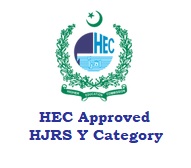Study of gamma spectroscopy and radiological health hazards of primordial radionuclides in granite samples of district Swabi, Pakistan
DOI:
https://doi.org/10.47264/idea.nasij/5.2.5Keywords:
Radiological hazard, Primordial radionuclide, Natural radioactivity, Radioactivity levels, Gama-ray detector, HPGe, UNSCEAR, 226Ra, 232Th, 40KAbstract
This research evaluates natural radioactivity levels of Primordial Radionuclides 226Ra, 232Th, and 40K and the associated radiological hazards in granite samples of District Swabi, Pakistan. This was accomplished by employing a High Purity Germanium (HPGe) gamma-ray detector, and a total of 20 granite samples were analysed. Average specific activity levels were determined to be 4.470, 11.812, and 140.738 Bq/kg for 232Th, 226Ra, and 40K, respectively. As a result, a total average activity of 157.021 Bq/kg was found in the Swabi granite samples. Given their possible health risks, such as cancer, and the long-term effects of continual exposure through breathing, it is critical to investigate the radiological dangers posed by these primordial radionuclides. 232Th activity is 3%, 226Ra is 7%, and 40K is 90% of the total. The measured activity concentrations were then used to determine the radium equivalent, the excessive lifetime cancer risk, and different indoor and outdoor radiological hazard indices. The estimated values for these indices were discovered to be well within the safe ranges advised by the United Nations Scientific Committee on the Effects of Atomic Radiation (UNSCEAR). As a result, the study found that granite from the Swabi district is considered safe for construction use.
References
Ali, M., Iqbal, S., Wasim, M., Arif, M., & Saif, F. (2013). Soil radioactivity levels and radiological risk assessment in the highlands of Hunza, Pakistan. Radiation Protection Dosimetry, 153(3), 390–399. https://doi.org/10.1093/rpd/ncs102 DOI: https://doi.org/10.1093/rpd/ncs102
Almayahi, B. (2019). Use of gamma radiation techniques in peaceful applications. Intech Open.
American Cancer Society. (n.d.). Radiation exposure and cancer risk. https://www.cancer.org/cancer/risk-prevention/radiation-exposure.html
Choubedar, F. (2000). Use of radio-nuclides (unsupported 210Pb, 7Be and 137Cs) in air, rain and undisturbed soil as environmental tools. Edinburgh Research Archive. https://era.ed.ac.uk/handle/1842/13381
Dutch, D. R. (2018). Natural radioactivity, radiation exposure. The JRI Briefing Paper No. 37. https://jri.org.uk/wp-content/uploads/2018/08/BP37_Natural_Radioactivity_Dutch.pdf
EPA. (2016). A citizen's guide to radon. United States Environmenal Protection Agency (EPA). https://www.epa.gov/sites/default/files/2016-12/documents/2016_a_citizens_guide_to_radon.pdf
EPA. (2024, October 1). Radiation Basics. United States Environmenal Protection Agency (EPA). https://www.epa.gov/radiation/radiation-basics
International Atomic Energy Agency. (2018). Radiation protection and safety of radiation sources. https://www-pub.iaea.org/MTCD/Publications/PDF/Pub1578_web-57265295.pdf
Krane, K. S. (1991). Introductory nuclear physics. John Wiley.
Korany, K., & Yousef, H. (2019). Assessment of radiological hazard indices in Abu Rusheid area, south eastern desert, Egypt, using gamma ray spectroscopy. Arab Journal of Nuclear Sciences and Applications, 52(2), 132–141. https://journals.ekb.eg/article_29186.html DOI: https://doi.org/10.21608/ajnsa.2019.5168.1121
Likuku, A. S. (2003). The Influence of topography and vegetation canopy on the deposition of atmospheric particulates Studied with 210Pb and 137Cs soil inventory measurements. Doctoral dissertation, University of Edinburgh. https://researchhub.buan.ac.bw/handle/13049/159
Lindstrom, R. M., Lindstrom, D. J., Slaback, L. A., & Langland, J. K. (1990). A low-background gamma-ray assay laboratory for activation analysis. Nuclear Instruments and Methods in Physics Research Section A: Accelerators, Spectrometers, Detectors and Associated Equipment, 299(1-3), 425–429. https://doi.org/10.1016/0168-9002(90)90818-Q DOI: https://doi.org/10.1016/0168-9002(90)90818-Q
NIST. (2021). Radioactivity group. National Institute of Standards and Technology. https://www.nist.gov/pml/radiation-physics/radioactivity
Pakistan Bureau of Statistics. (2017). Pakistan population census district wise. https://www.pbs.gov.pk/census-2017-district-wise
Rahman, S. U., Rafique, M., Jabbar, A., & Matiullah. (2013). Radiological hazards due to naturally occurring radionuclides in the selected building materials used for the construction of dwellings in four districts of the Punjab province, Pakistan. Radiation Protection Dosimetry, 153(3), 352–360. https://doi.org/10.1093/rpd/ncs109 DOI: https://doi.org/10.1093/rpd/ncs109
Ramsiya, M., Joseph, A., & Jojo, P. J. (2017). Estimation of indoor radon and thoron in dwellings of Palakkad, Kerala, India using solid state nuclear track detectors. Journal of Radiation Research and Applied Sciences, 10(3), 269–272. https://doi.org/10.1016/j.jrras.2017.05.004 DOI: https://doi.org/10.1016/j.jrras.2017.05.004
Sherar, M. A. S., Visconti, P. J., Ritenour, E. R., & Haynes, K. W. (2021). Radiation protection in medical radiography (9th Ed.). Elsevier. https://evolve.elsevier.com/cs/product/9780323825030?role=student
Sutton, G. A., Napier, S. T., John, M., & Taylor, A. (1993). Uranium-238 decay chain data. Science of the Total Environment, 130, 393–401. https://doi.org/10.1016/0048-9697(93)90094-M DOI: https://doi.org/10.1016/0048-9697(93)90094-M
Tsapaki, V., Balter, S., Cousins, C., Holmberg, O., Miller, D. L., Miranda, P., ... & Vano, E. (2018). The International Atomic Energy Agency action plan on radiation protection of patients and staff in interventional procedures: achieving change in practice. Physica Medica, 52, 56–64. https://doi.org/10.1016/j.ejmp.2018.06.634 DOI: https://doi.org/10.1016/j.ejmp.2018.06.634
Trevisi, R., Leonardi, F., Risica, S., & Nuccetelli, C. (2018). Updated database on natural radioactivity in building materials in Europe. Journal of Environmental Radioactivity, 187, 90-105. https://doi.org/10.1016/j.jenvrad.2018.01.024 DOI: https://doi.org/10.1016/j.jenvrad.2018.01.024
Tzortzis, M., Tsertos, H., Christofides, S., & Christodoulides, G. (2003). Gamma-ray measurements of naturally occurring radioactive samples from Cyprus characteristic geological rocks. Radiation Measurements, 37(3), 221–229. https://doi.org/10.1016/S1350-4487(03)00028-3 DOI: https://doi.org/10.1016/S1350-4487(03)00028-3
UNSCEAR. (1993). Sources and effects of ionising radiation. United Nations Scientific Committee on the Effects of Atomic Radiation (UNSCEAR) Report to the General Assembly with Scientific Annexes. https://www.unscear.org/docs/publications/1993/UNSCEAR_1993_Report.pdf
Wasim, M., Iqbal, S., & Ali, M. (2016). Radiological and elemental analysis of soils from Hunza in Central Karakoram using gamma-ray spectrometry and k 0-instrumental neutron activation analysis. Journal of Radioanalytical and Nuclear Chemistry, 307, 891–898. https://doi.org/10.1007/s10967-015-4220-4 DOI: https://doi.org/10.1007/s10967-015-4220-4
WHO. (2023). Radon. World Health Organization (WHO). https://www.who.int/news-room/fact-sheets/detail/radon-and-health
Younis, H., Qureshi, A. A., Manzoor, S., & Anees, M. (2018). Measurement of radioactivity in the granites of Pakistan: a review. Health Physics, 115(6), 760–768. https://doi.org/10.1097/HP.0000000000000917 DOI: https://doi.org/10.1097/HP.0000000000000917
Younis, H., Ahmad, F., Shehzadi, R., Asghar, I., Ahmad, T., Ajaz, M., ... & Haj Ismail, A. A. K. (2021). Study of radioactivity in Bajaur Norite exposed in the Himalayan tectonic zone of Northern Pakistan. Atmosphere, 12(11), 1385. https://doi.org/10.3390/atmos12111385 DOI: https://doi.org/10.3390/atmos12111385
Downloads
Published
How to Cite
Issue
Section
License
Copyright (c) 2024 Jamil Khan, Ayaz Ali , Muhammed Waseem, Amar Shoukat

This work is licensed under a Creative Commons Attribution 4.0 International License.
Please click here for details about the Licensing and Copyright policies of NASIJ.












